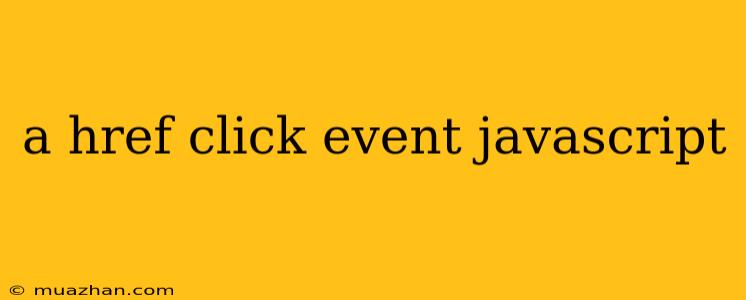A href Click Event in JavaScript
The <a> tag, or anchor tag, is a fundamental part of HTML, used for creating hyperlinks. In web development, we often need to manipulate the default behavior of these links, or perform actions when they are clicked. This is where JavaScript's event handling comes in.
Understanding the Click Event
The "click" event is triggered when a user clicks on an <a> tag. JavaScript provides a way to listen for this event and execute custom code when it occurs. This allows for a wide range of possibilities, such as:
- Preventing default behavior: You can stop the link from navigating to a new page or performing its intended action.
- Executing custom functions: You can run JavaScript code, like displaying an alert, making an API call, or changing the content of the page.
- Dynamically changing the link: You can modify the link's destination URL or other attributes in response to user interaction.
Implementing the Click Event
To capture the click event in JavaScript, you can use the addEventListener() method. Here's how:
- Select the element: Use JavaScript's
document.querySelector()ordocument.getElementById()to find the specific<a>tag you want to target. - Add the event listener: Call the
addEventListener()method on the selected element, passing in the event type ("click") and the function to execute when the click event happens.
Here's an example:
A href Click Event Example
Click Me
In this code:
- We get a reference to the
<a>tag withdocument.getElementById("myLink"). - We attach a "click" event listener to the link.
- Inside the event handler function:
event.preventDefault()prevents the link from navigating tohttps://www.example.com.alert("You clicked the link!")displays an alert message.console.log("Link URL:", link.href);logs the link's URL to the console.
Additional Considerations
- Event Object: The
eventobject passed to the event handler provides information about the event, such as the target element (event.target) and the key that triggered the event (event.key). - Multiple Event Listeners: You can attach multiple event listeners to the same element. They will be executed in the order they were added.
- Event Bubbling: Event listeners can be attached to parent elements and triggered by child elements. This is known as event bubbling. You can use
event.stopPropagation()to stop the event from bubbling up the DOM tree.
Understanding a href click events in JavaScript is crucial for creating interactive and engaging web applications. By learning how to handle these events, you can enhance user experiences and implement complex functionalities.
